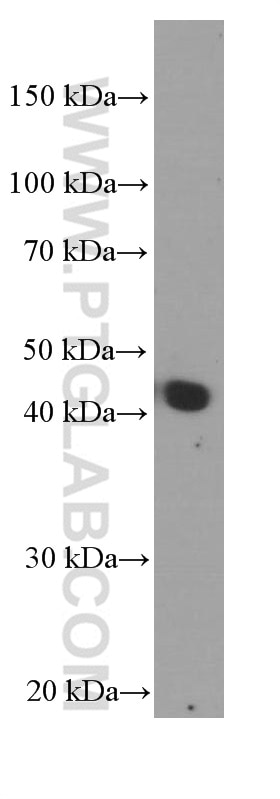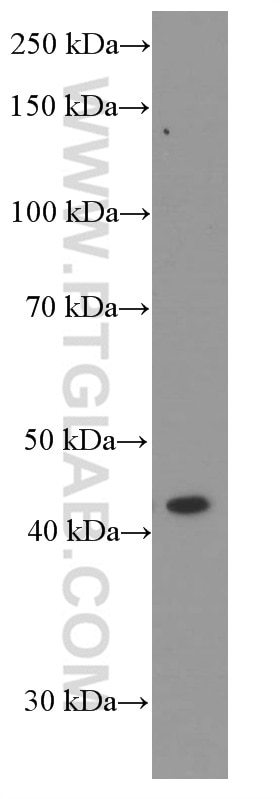APOA4 Monoklonaler Antikörper
APOA4 Monoklonal Antikörper für WB,ELISA
Wirt / Isotyp
Maus / IgG1
Getestete Reaktivität
human
Anwendung
WB,ELISA
Konjugation
Unkonjugiert
CloneNo.
3A9A8
Kat-Nr. : 66252-1-Ig
Synonyme
Galerie der Validierungsdaten
Geprüfte Anwendungen
| Erfolgreiche Detektion in WB | humanes Plasmagewebe, L02-Zellen |
Empfohlene Verdünnung
| Anwendung | Verdünnung |
|---|---|
| Western Blot (WB) | WB : 1:1000-1:8000 |
| It is recommended that this reagent should be titrated in each testing system to obtain optimal results. | |
| Sample-dependent, check data in validation data gallery | |
Produktinformation
66252-1-Ig bindet in WB,ELISA APOA4 und zeigt Reaktivität mit human
| Getestete Reaktivität | human |
| Wirt / Isotyp | Maus / IgG1 |
| Klonalität | Monoklonal |
| Typ | Antikörper |
| Immunogen | APOA4 fusion protein Ag12454 |
| Vollständiger Name | apolipoprotein A-IV |
| Berechnetes Molekulargewicht | 396 aa, 45 kDa |
| Beobachtetes Molekulargewicht | 45-46 kDa |
| GenBank-Zugangsnummer | BC074764 |
| Gene symbol | APOA4 |
| Gene ID (NCBI) | 337 |
| Konjugation | Unkonjugiert |
| Form | Liquid |
| Reinigungsmethode | Protein-G-Reinigung |
| Lagerungspuffer | PBS mit 0.02% Natriumazid und 50% Glycerin pH 7.3. |
| Lagerungsbedingungen | Bei -20°C lagern. Nach dem Versand ein Jahr lang stabil Aliquotieren ist bei -20oC Lagerung nicht notwendig. 20ul Größen enthalten 0,1% BSA. |
Hintergrundinformationen
APOA4 is a major protein component of chylomicrons in postprandial lymph and plasma. It is synthesized in the small intestine and the liver, attached to chylomicrons by enterocytes, and secreted into intestinal lymph during fat absorption. APOA4 is intimately involved in metabolism and has protective roles in cardiovascular diseases like atherosclerosis. APOA4 can promote INS secretion and maintain glucose homeostasis. It also has potent antioxidant and anti-inflammatory properties.
Protokolle
| Produktspezifische Protokolle | |
|---|---|
| WB protocol for APOA4 antibody 66252-1-Ig | Protokoll herunterladen |
| Standard-Protokolle | |
|---|---|
| Klicken Sie hier, um unsere Standardprotokolle anzuzeigen |



